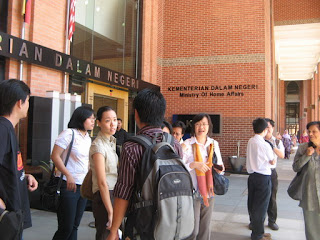The koel bird is back with its noisy call. Woke me up yesterday morning, 27 Dec 2008. I find the call very irritating!!
The bird is migatory and seems to pass through KL twice a year. It is a type of cuckoo, and like other members of the cuckoo family, it lays its eggs in the nests of crows, so that the young are raised by crows. According to Wikipedia, it migrates to warmer climates in winter, so as it has just arrived in KL in Dec, it must have come from a colder country. At a guess, it is the Asian Koel.
The call is loud, distinctive........... and irrating. It seems to scream rather than call, drawing out the last syllable - ko ellll. Apparently it is the male which makes this call.
Although I often hear the koel, it is quite difficult to see the actual bird. Managed to take these photos from my window using the zoom, lousy photos, but at least I managed to shoot the bird! The photos were taken in May 2007 and 2008.
I made a note of when I heard the bird and it was almost every morning until Jan 27 when I went away. It called only in the morning, usually between 7-8 am though sometimes was later. It was still calling when I got back in mid Feb.
And when I was in Bangkok at the end of Jan, the first thing I heard from my hotel was............... yes......... that wretched koel bird !
There are good photos of the koel on Wikipedia.
--------------
Update 2010
I came back to KL in mid Jan and the koel was calling. It was still there Jan 27. By early Feb I heard one calling occasionally. I was in south Thailand first week in Feb and the koel was there as well! Towards the end of Feb there seemed to be less calling, though one was still waking me around 7am in early March. Mid March and I occasionally heard one calling. It's been excessively hot since end of Jan, so maybe the koels are staying longer than normal cos of the heat.
I was away mid Mar till end of May. Then forgot about it, but I realised by mid July that I hadn't heard the koel at all for at least a month, maybe longer.
I didn't hear it again until Nov 13, when one bird called for a short time. Nov 18 it was calling again. I suppose it will be here now for the (European) winter. From 23 Nov I heard one calling almost every day, I still heard it in early March.
© Liz Price




















































































